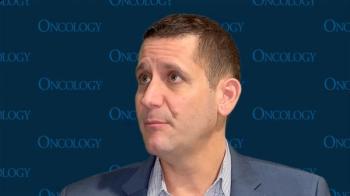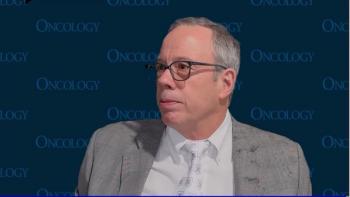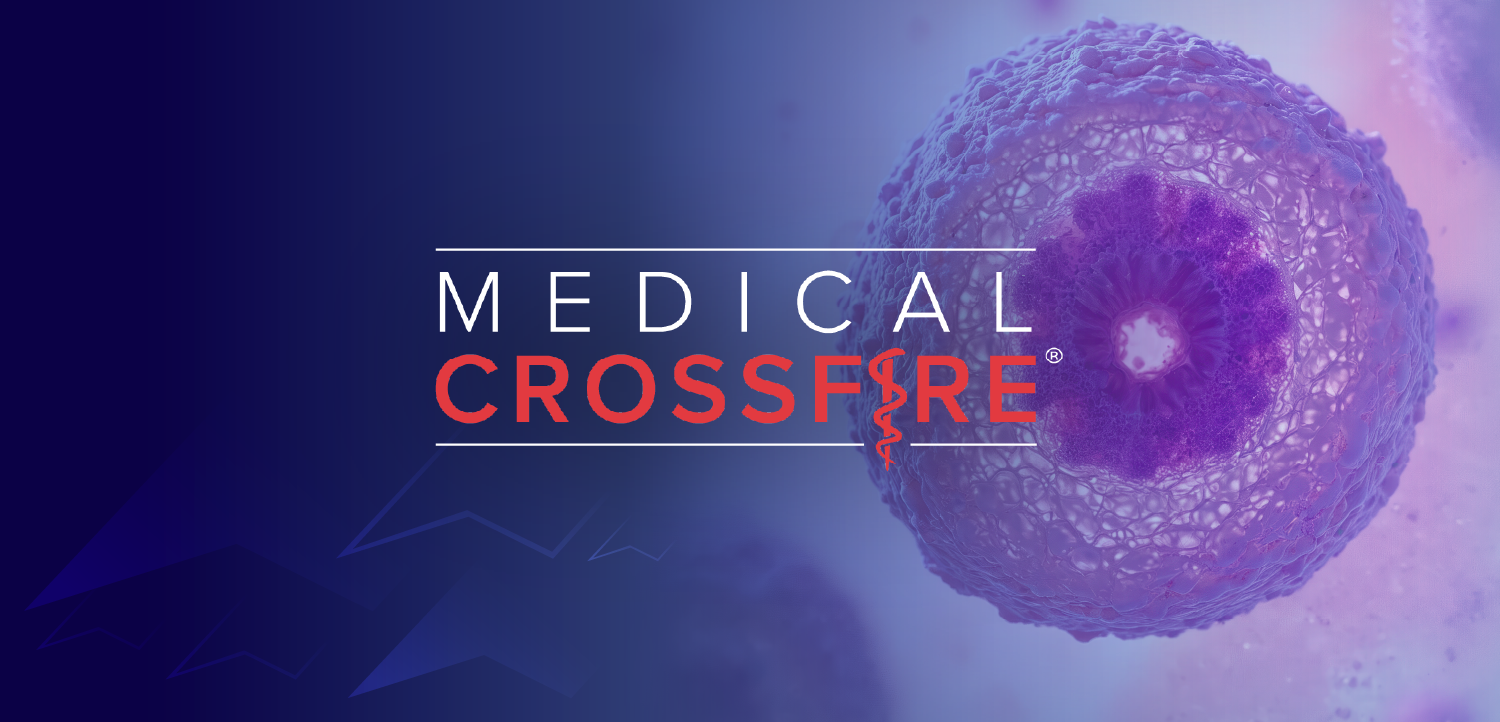
Integrating Lorlatinib Into First-Line ALK-Positive NSCLC Treatment
Findings from the phase 3 CROWN trial evaluating lorlatinib in ALK-positive non–small cell lung cancer revealed a sustained PFS benefit with the agent.
As part of a Meeting of the Minds program, CancerNetwork® hosted a panel discussion focused on assessing the clinical efficacy and safety of lorlatinib (Lorbrena) as a first-line treatment for patients with stage IIIB to IV ALK-positive non–small cell lung cancer (NSCLC). Highlighting data from the phase 3 CROWN trial (NCT03052608) presented at the
The panel was led by Todd Bauer, MD, professor of medical oncology, associate director of Drug Development, and principal investigator at the Sarah Cannon Research Institute. Panelists included Johnathan W. Riess, MD, MS, associate professor of medicine and director of Thoracic Oncology at the University of California Davis Health Medical Center; and Sandip Patel, MD, professor of medical oncology at the Moores Cancer Center at UC San Diego.
Evaluating the Phase 3 CROWN Trial Results
Bauer: [Presented] at 2024 ASCO, and then updated in the fall meetings as well, the 5-year [phase 3 CROWN trial] update for lorlatinib came out. Can you speak to that a bit?
Reiss: It was impressive data. The CROWN trial was a randomized, global phase 3 study that took patients with stage IIIB to IV ALK-positive NSCLC. Asymptomatic, treated, or untreated CNS metastases were allowed. Patients [were randomly assigned] 1:1 to [receive] lorlatinib at 100 mg once daily or crizotinib, which is the first-[line] ALK inhibitor.1 The primary end point was PFS by blinded independent central review.
What was noteworthy at the 2024 ASCO meeting was they did a post-hoc analysis at 5 years, with the primary end point of PFS and it was exceptional. At 60.2 months of median follow-up, the median PFS by the investigator was still not reached with lorlatinib. The HR was 0.19. It was highly statistically significant, and the most meaningful end point for me, looking at the data, at 5 years, 60% of patients had not progressed on lorlatinib; more than half of patients were progression-free after 5 years.
To me, it was incredible, and the benefit was seen across all subgroups. The main group of patients, alluding to this case, is [those] with brain metastases did exceptionally well. [For] patients with baseline brain metastases, the HR for PFS was 0.08. When we do clinical trials, we rarely see HRs like that. In patients [with] brain metastasis, the intracranial activity was exceptional. The HR [for intracranial PFS] was 0.06.
At 5 years, 92% of patients had not [experienced] intracranial progression. To my mind [it was] exceptional data. I do not know of any other targeted therapy that has this type of benefit in the metastatic setting, and it was impressive.
Bauer: In lung cancer specifically, but in all cancers, there has never been a single targeted therapy that had this degree of PFS. What is the current landscape, how do we sequence these drugs, and is lorlatinib, based on this data, the right drug for everyone?We have to do cross trial comparisons between the phase 3 ALTA-1L trial (NCT02737501), the phase 3 ALEX trial (NCT02075840), and CROWN.2,3 It is basically the same trial design [between the 3] with some important some [discrepancies] between them.
The PFS not reached at 5 years is impressive and the CNS activity is impressive. Lorlatinib likely has slotted itself, from an efficacy standpoint, as the first-line preferred option. The NCCN still has [other options] listed––alectinib, brigatinib, and lorlatinib––as preferred.4 I would look to see that adjust in the coming months. Much discussion has been made about lorlatinib, and we are going to get into that in a minute.
As we do with all of our patients, we have to take our patient at baseline and decide if the most effective drug is the best drug for this patient. Because in no other cancers do we save a better drug for later because we are worried about the [adverse] effects. With testicular cancer, we give bleomycin, etoposide, and platinum chemotherapy [BEP] because we do not worry about cisplatin toxicity. We have to pick the best drug first.
Knowing some of the [adverse] effects we are going to talk about, if I have a patient who has severe familial hypercholesterolemia or a baseline, severe psychiatric comorbidity, that is when you start looking at some of the second-line drugs as well, alectinib and brigatinib, for starting as the first-line agent. Short of those agents, it does seem to me that the CROWN data has to put lorlatinib towards the front.
Assessing Lorlatinib Feasibility in Real-World Practice
Bauer: We know that the data always sounds great, but in your experience, have you seen patients do well with this drug?
Patel: Lorlatinib is a reasonable treatment approach for this patient [population] and for [those with CNS metastases]. Some other subgroups that are of interest are high-risk co-mutations, such as EML4-ALK variant 3, which is traditionally more resistant to other ALK tyrosine kinase inhibitors (TKIs)––this is not an formal comparison––and in co-mutation, for example, with P53. These are some of the scenarios [where] clearly lorlatinib has distinguished itself, brain metastases being the third subgroup
[With] alectinib and brigatinib, we have used these drugs for quite a while, with market efficacy in the CNS. In fact, we use alectinib in the adjuvant setting if you are out resected. There are roles for these different agents. The toxicities differ. [With] brigatinib, we sometimes get a myositis or an initial lung disease that we have to dose de-escalate on. With alectinib, we can get liver toxicity. Then, with lorlatinib, it is the neuropsychiatric and neurocognitive [adverse] effects that we have to learn to manage.
The hypercholesterolemia, our drugs are robust for that, and that has not been a struggle in our clinic. It is the neurocognitive and neuropsychiatric [adverse] effects [that are]. In this case, for a working-aged woman with this diagnosis, if we put them on a full dose of lorlatinib, and they have any issues, we can dose-reduce. To me, the most impressive thing about Dr. Benjamin J Solomon’s presentation from ASCO was that if you reduce the dose, you preserve PFS, and I think that is an important point.
Our patients want to maximize their benefit, and they correlate that with dose, and I get that mindset, but at what cost? If you could dose reduce and get over some of those neurocognitive [adverse] effects for which we do not have effective supportive care treatments for, and the patient can continue safely, to me that is a winning battle. That is the discussion I have with patients.
One important point I make when folks prescribe drugs like lorlatinib is, do not [schedule an appointment to] see them back in a month for their first visit after you start them [on treatment]. See them back the week after [beginning treatment], like you started on chemotherapy. You can space out their visits after they are through their first set of scans. It is important to see that patient a week, maybe 2 weeks at most after they start, because if they are going to get any of these neurocognitive or neuropsychiatric [adverse] effects, they will emerge early. If you can hold the drug, recover things, and get them on a lower dose, you can continue effective therapy.
Defining Roles for Second-Generation Therapy in ALK-Positive NSCLC
Bauer: Are there any particular factors when you are sitting down talking to your patient [that determine] if [you are] going to pick one of the second-generation drugs vs third-generation lorlatinib?
Reiss: Looking at cross-trial comparisons, the PFS for lorlatinib was 60% progression-free at 5 years, which was an improvement over what we see over alectinib or brigatinib, where you’re looking at [approximately] 2.5 or 3 years. That is a big jump. Again, they have not been compared head-to-head.
Certainly, if there are issues with cognitive changes or some AEs, alectinib is generally well tolerated [and] has its own unique [AE] profile of transaminitis, creatine phosphokinase elevation, edema, and weight gain, but again, is generally well tolerated. Brigatinib has pulmonary toxicity early on, and transaminitis. I usually individualize it to the patient. The updated CROWN data was impactful for me and my patient selection.
Bauer: It has been so easy for so long to say, “Hey, this is a great drug. It is well tolerated. Take it.” To now, we have to think through it a bit, and it is a bit more hands-on management. One of the other things that came out of the CROWN data that is interesting is the number of patients that did have to be dose adjusted or dose modified was high, [approximately] 50% of patients, but only 7% of patients had to [discontinue] lorlatinib due to treatment-related AEs. That tells me, if you read between those lines, with appropriate management, patients can tolerate it and stay on it as well as, if not better than, the other TKIs.
This then begs the question that if we like this as the first-line agent, and then [patients] get started on it now or however many years down the road, and they progress, what do we do? Remember, lorlatinib was designed to be a rescue medicine. What do we do when we have used the best drug first?
Christine M. Lovly, MD, PhD, has a great quote: “Remember, chemotherapy is not a bad word. It still works.” The AEs can be managed, and it is usually highly effective in this population. The one thing that everyone would probably agree with is that the utilization of checkpoint inhibitors in an ALK-positive world is the one wrong answer. Those drugs do not work, regardless of what tends to be a higher PD-L1 expression, those drugs do not carry with them efficacy in the outpatient world. It is chemotherapy and the creative use of radiation to prolong and treat oligometastases if they occur.
In the ALK world, where somebody comes in and they have been on alectinib therapy for x months or a year or 2, and they say, “Hey, the CROWN data looks great. Can I switch?” Have you gotten that yet, and how are you handling it?
Patel: I have, and I think it is an important question. My answer is often, it is not a question of if, it is a question of when. You would use lorlatinib if they are on alectinib or brigatinib in the second line setting. There are other fourth-line ALK inhibitors that are in development, and by the time many of the [patients] who get started this year would have to talk about progression, these new agents will be available. It is a discussion around timing.
If someone has been on it a while they are tolerating it there is not a reason to change. I typically would continue and then offer lorlatinib on progression. If you have a sense of what the drug does. But you make a counterpoint. The CNS benefit with lorlatinib is quite robust, and then for someone with ELM4-ALK variant 3 or P53 mutations, if they are early, in their first couple months, you can have that discussion. My view is, if they are tolerating it well and they have been on it a while, we can use predictive biomarkers, but the best biomarkers are how the patient is doing.
The proof is in the pudding there, and I tend to continue to have those discussions. [They are important] to have. Patients need to understand that their physicians understand the latest therapies that are available to them.
References
- Solomon BJ, Liu G, Felip E, et al. Lorlatinib versus crizotinib in patients with advanced ALK-Positive non–small cell lung cancer: 5-year outcomes from the phase III CROWN study. J Clin Oncol. 2024; 42(29):3400-3409. doi:10.1200/JCO.24.00581
- Camidge DR, Kim HR, Ahn MY, et al. Brigatinib versus crizotinib in ALK-positive non–small-cell lung cancer. N Engl J Med. 2018;379(21):2027-2039. doi:10.1056/NEJMoa1810171
- Peters S, Camidge DR, Shaw AT, et al. Alectinib versus crizotinib in untreated ALK-positive non–small-cell lung cancer. N Engl J Med. 2017;377(9):829-838. doi:10.1056/NEJMoa1704795
- NCCN. Clinical Practice Guidelines in Oncology. Metastatic non–small cell lung cancer, version 7, 2024. Accessed March 24, 2025. https://tinyurl.com/ydmur5ht
Newsletter
Stay up to date on recent advances in the multidisciplinary approach to cancer.

















































































